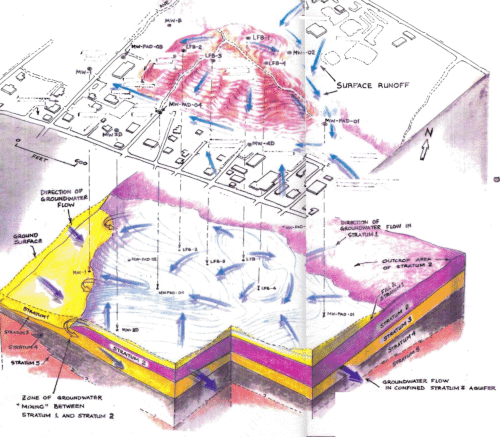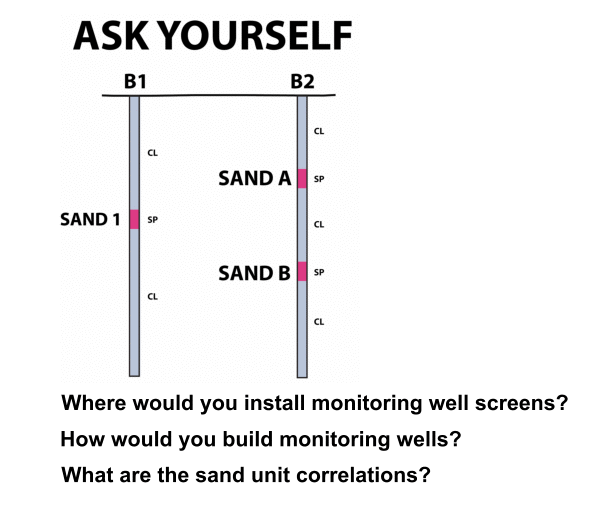DESIGNING AND OPTIMIZING GROUND WATER MONITORING SYSTEMS IN SEDIMENTARY SEQUENCES: PART 1: Deciphering Sedimentary Sequences and Targeting Meaningful Monitoring Units
Join us for this new three-part webinar series dedicated to designing and optimizing ground water monitoring systems in sedimentary sequences. Each part is 90-minutes and allows for 1.5 Professional Development Hours (PDH). You receive a copy of the webinar slides and a free Record of Attendance Form to distribute to participants at your computer site location.
Discover the key applications for effective well placement and ground water monitoring system design in sedimenary stratigraphic sequences. Application of design efficiencies will apply to glacial, alluvial, and fluvial sedimentary environments.

Learn ways to optimize your ground water monitoring system by:
- Eliminating redundant monitoring wells
- Targeting laterally-continuous monitoring units and avoiding isolated sand lenses
- Avoiding invalid potentiometric surface maps
- Identifying meaningful monitoring units and placing effective wells
- Recognizing the water table in low permeable formations
- Making the right field observations and communicating them effectively
- Applying conditions from the case studies to your own scenarios and sites
The three-part series is presented in a step-wise process beginning with basic field testing and concluding with case studies of different sedimentary sequences to illustrate successes and failures of system design and optimization.

Register Now for this 3-part webinar series and learn to design ground water monitoring systems by installing properly-built wells in meaningful ground water monitoring units.
Part One begins with defining terms and philosophies. We will present some common problems that prevent us from efficient work and then provide options for solutions. We will examine different sedimentary sequences ranging from glacial to fluvial to gulf coast sediments for taking the mystery out of the subsurface and building a ground water monitoring system.
Part One also includes some Points to Ponder including the misuse of high-resolution sampling and misuse of the TRIAD sampling approach coupled with common misconceptions about mapping hydraulic conductivity and the consequences of basing monitoring system design on hydraulic conductivities alone.
We will conclude with the necessary information required to build a defensible ground water monitoring system that is efficient using a system that yields reproducible results.
Webinar Highlights:
- Introduction: Definitions and Common Challenges
- Hydrostratigraphy: Do's and Don'ts
- Misuse of High-Resolution Subsurface Sampling
- Fundamentals of geologic field analysis, boring correlations and targeting meaningful ground water monitoring units
"The webinar instructors are knowledgeable and teach real-world examples to put things in perspective. Great to hear passionate geoscientists teaching what they know best. Overall, great (online) courses!"
- Andrew Canali, Jacobs Engineering, Inc.
"The training webinars are of high quality. They were easy to use... We projected our webinars to a large screen TV mounted on the wall in our conference room. We had good clarity for sound and picture...
The content was also appropriate. Personally, I liked the overall message that high quality soil boring logs are essential to better understanding of site characterizations. How can we adequately assess the nature & extent of environmental impact (and the selected remedial actions) without adequate site characterizations."
- Mark Nichter, US Army Corp of Engineers
"I truly enjoyed the Midwest Geoscience Group 'Designing and Optimizing Groundwater Monitoring Systems in Sedimentary Sequences Part 3' webinar. It was really stimulating to listen to the applicability of fundamental geologic principles to real life case studies. The instructors did an outstanding job explaining vertical seepage rates and preferential flow paths in aquitards as well as emphasizing the importance of deposition in understanding sediment extent and connectivity. Other interesting concepts were the effect of buried weathering zones on groundwater movement and importance of not relying on soil classification alone when determining preferential pathways for groundwater and contaminant migration. I highly recommend this webinar."
- Ada Lichaa, Texas Commission of Environmental Quality
Instructors Bio
Dave Hart, PhD, PG
 Dave Hart is a hydrogeologist/geophysicist with the Wisconsin Geological and Natural History Survey and an associate professor at the University of Wisconsin-Extension.
Dave Hart is a hydrogeologist/geophysicist with the Wisconsin Geological and Natural History Survey and an associate professor at the University of Wisconsin-Extension.
Dave's applied research includes regional groundwater flow and recharge in southeastern Wisconsin, near-surface geophysics, and measurement of porosities and permeabilities in aquifers and aquitards. Prior to joining the university, he served as a hydrogeologist with Eder Associates. He is an associate editor for Ground Water and past president of the AWRA - Wisconsin Section.
Dan Kelleher, PG, CIPM
 Dan Kelleher is a hydrogeologist who strives for excellence in subsurface characterization. Dan earned his bachelor's degree from Monmouth College and master's degree at Northern Illinois University. His technical expertise is quantitative hydrogeology (in porous and fractured media), geotechnical analysis of sedimentary sequences, aquifer testing and predictive ground water modeling. He promotes field analysis during stratigraphic characterization from boring to boring in order to utilize QA/QC processes fully throughout a project and help identify unexpected conditions as soon as they arise.
Dan Kelleher is a hydrogeologist who strives for excellence in subsurface characterization. Dan earned his bachelor's degree from Monmouth College and master's degree at Northern Illinois University. His technical expertise is quantitative hydrogeology (in porous and fractured media), geotechnical analysis of sedimentary sequences, aquifer testing and predictive ground water modeling. He promotes field analysis during stratigraphic characterization from boring to boring in order to utilize QA/QC processes fully throughout a project and help identify unexpected conditions as soon as they arise.